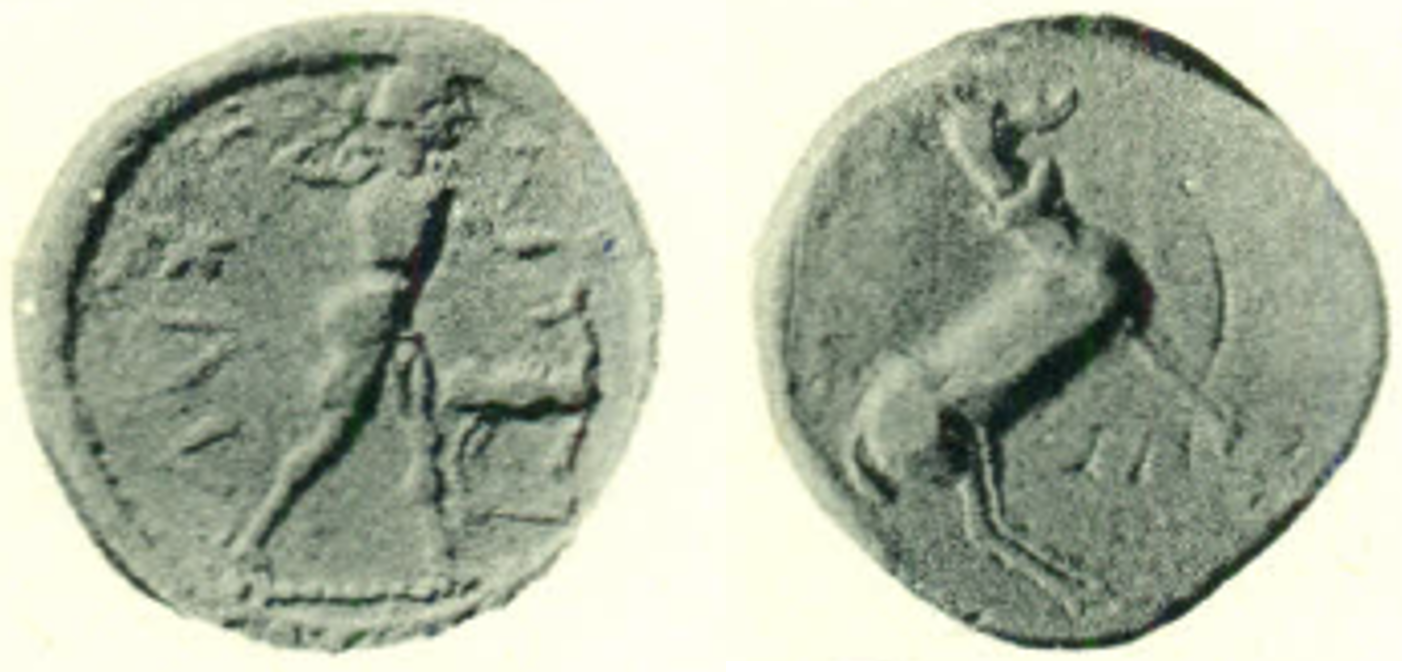3699 - Caulonia (nomos Apollo/stag) over Agrigentum (eagle/crab) (Cambridge, FM, McClean coll. 1598): Difference between revisions
From SILVER
No edit summary |
No edit summary |
||
| Line 24: | Line 24: | ||
|Overstruck date to=450 BCE | |Overstruck date to=450 BCE | ||
|Overstruck period=Classical | |Overstruck period=Classical | ||
|Overstruck denomination=didrachm | |||
|Coin series reference overstruck=Westermark 2018 | |Coin series reference overstruck=Westermark 2018 | ||
}} | }} | ||
Revision as of 14:55, 17 August 2023
475 BCE - 425 BCEΚΑV
Location/history
| Museum collectionMuseum collection: | Cambridge, Fitzwilliam Museum, CM.MC.1598-R | |
| Private collection(s)Private collection(s) ᵖ: | McClean collection |
Overstriking coin
Description
| ObverseInscription or printing placed on the obverse.: | ΚΑV (Greek) Apollo advancing right, naked, brandishing laurel branch with right hand, a small daimon running on outstretched left arm. In right field, stag standing right. Ornemented border. | ReverseInscription or printing placed on the reverse.: | Stag standing right. |
Mint and issuing power
| MintIdentifies the place of manufacture or issue of a numismatic object.: | Caulonia | Ancient regionAncient region. | Bruttium | Modern countryModern country: Italy | AuthorityIdentifies the issuing power. The authority can be "pretended" when the name or the portrait of X is on the coin but he/she was not the issuing power. It can also be "uncertain" when there is no mention of X on the coin but he/she was the issuing power according to the historical sources: |
Chronology
| FromIdentifies the initial date in a range assigned in a numismatic context. 475 BCE toIdentifies the final date in a range assigned in a numismatic context.. 425 BCE | Classical 480-323 BC |
Physical description
| MetalThe physical material (usually metal) from which an object is made.: Silver |
WeightWeight of the numismatic object (in grams). in grams: 7.827.82 g <br />7,820 mg <br /> | DenominationTerm indicating the value of a numismatic object. Examples: tetradrachm, chalkous, denarius.: didrachm |
|
| StandardStandard.: Achaian | |||
References
| Coin referenceReference of the Coin: | Noe 1957, p. 13-42, pl. V-XIV (group VI, p. 30, pl. X, g), Grose 1979, p. 190, n° 1598 and pl. 50, n° 11. | Coin series referenceReference to coin series study: | SNG ANS/Sylloge Nummorum Graecorum1SNG ANS/Sylloge Nummorum Graecorum, USA, The Collection of the American Numismatic Society (9 vols.), New York, 1969-1998, n° 175-180., HN Italy2HN Italy, n° 2044, 2046, 2049, 2051-2152, HGC 13HGC 1, n° 1419 |
| Coin series web referenceCoin series web references: | |||
Overstruck type
Description
| ObverseInscription or printing placed on the obverse.: | ReverseInscription or printing placed on the reverse.: |
Mint and issuing power
| MintIdentifies the place of manufacture or issue of a numismatic object. ᵖ: | Agrigentum | Ancient regionAncient region. ᵖ | Sicily | Modern countryModern country: Italy | AuthorityIdentifies the authority in whose name (explicitly or implicitly) a numismatic object was issued. ᵖ: |
Chronology
| FromIdentifies the initial date in a range assigned in a numismatic context. 520 BCE toIdentifies the final date in a range assigned in a numismatic context.. 450 BCE | Classical 480-323 BC |
Physical description
| DenominationTerm indicating the value of a numismatic object. Examples: tetradrachm, chalkous, denarius. ᵖ: | didrachm |
References
| Coin type referenceReference to coin series study ᵖ: | Westermark 20184Westermark 2018 |
Additional data
| Frequency of overstrikesFrequency of overstrikes: | Level of confidenceLevel of confidence of the identification: | ||
| RemarksRemarks: | |||
